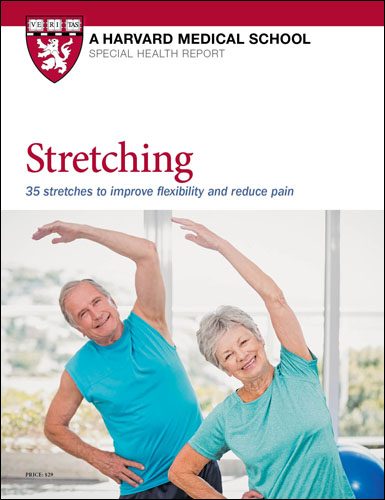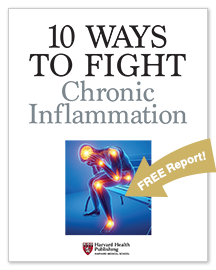
Hemoglobin A1c (HbA1c): What to know if you have diabetes or prediabetes or are at risk for these conditions

What could be causing your blurry vision?

Avocado nutrition: Health benefits and easy recipes

Swimming lessons save lives: What parents should know

Preventing and treating iliotibial (IT) band syndrome: Tips for pain-free movement

Wildfires: How to cope when smoke affects air quality and health

What can magnesium do for you and how much do you need?

Dry socket: Preventing and treating a painful condition that can occur after tooth extraction

What happens during sleep — and how to improve it

How is metastatic prostate cancer detected and treated in men over 70?


Strength and Power Training for All Ages: 4 complete workouts to tone up, slim down, and get fit
Studies attest that strength training, as well as aerobic exercise, can help you manage and sometimes prevent conditions as varied as heart disease, diabetes, arthritis, and osteoporosis. It can also protect vitality, make everyday tasks more manageable, and help you maintain a healthy weight. Strength and Power Training for All Ages helps you take strength training to the next level by developing a program that's right for you.
Other Product Information
One of the best ways to stay fit and healthy as you age is by doing strength and power training exercises. You may know that starting in our 30s, we all begin to lose muscle mass. This loss actually contributes to achy joints, increased risk of injury, and the “middle-age spread” we all dread. What’s more, the older we get, the faster muscle mass disappears. That means that eventually, simple tasks like getting out of a chair and climbing stairs can become more difficult.
Strength training can help you build muscle, make you strong, increase your endurance and make everyday activities easier. By combining strength and power training exercises you’ll not only get stronger, you’ll build speed and improve your reaction time. That’s critical as you age, because it can help prevent falls.
Get your copy of Strength and Power Training for All Ages today and learn:
- the key muscles to work for a fit, injury-free body
- why you should count out loud as you lift weights
- how to strengthen the bones that are most likely to fracture — like your hips, spine, and wrists
- how to take pressure of your knees when walking or running
- exercise precautions you’ll need to take if you're taking a beta blocker
- why you’ll want to apply heat to sore joints before you exercise
- how just thinking about the muscle you’re working actually improves results
- how to tell how much weight is right for you — and how many sets of each exercise you should do
- and more.
Help your health with 4 total-body workouts:
- strengthen muscles
- build bones
- improve balance
- increase muscle power
- burn fat
- fight disease.
Plus get 2 Special Bonus Sections at no extra cost: Plyometrics Power Moves and Stretching Exercises.
Prepared by the editors of Harvard Health Publishing in consultation with Medical Editor Elizabeth Pegg Frates, M.D., Clinical Assistant Professor at Harvard Medical School; and Fitness Consultant Michele Stanten, Certified Fitness Instructor at the American Council on Exercise. 53 pages. (2024)
Age and muscle loss
No matter how many birthdays come and go, muscles perform the same type of action. But as muscle mass in the body shrinks with the passing years, strength also declines. Sarcopenia—the gradual decrease in muscle tissue—starts at around age 30. The average 30-year-old can expect to lose about 25% of muscle mass and strength by age 70 and another 25% by age 90.
Some of these changes stem from the physiological effects of aging, but disuse plays a bigger role than many people suspect. Studies of older adults consistently prove that a good deal of the decline in strength can be recouped with strength training.
Likewise, power can be regained. With age and disuse, the nerve-signaling system that recruits muscle fibers for tasks deteriorates. Fast-twitch fibers, which provide bursts of power, are lost at a greater rate than slow-twitch fibers. You might think of a nerve pathway as a set of paving stones leading to a destination. As the years pass, the path may become overgrown and disappear in spots rather than remain well traveled and clearly marked. Preliminary power training studies suggest that movements designed to restore neural pathways can reverse this effect.
Having smaller, weaker muscles doesn’t just change the way people look or move. Muscle loss affects the body in many ways. Strong muscles pluck oxygen and nutrients from the blood much more efficiently than weak ones. That means any activity requires less effort from the heart and therefore puts less strain on it. Strong muscles are also better at sopping up sugar in the blood and helping the body stay sensitive to insulin (which helps cells extract sugar from the blood). In these ways, strong muscles can help keep blood sugar levels in check—which in turn helps prevent or control type 2 diabetes. Strong muscles enhance weight control, too.
On the other hand, weak muscles hasten the loss of independence, as everyday activities—such as walking, cleaning, shopping, and even dressing—become more difficult. They also make it harder to balance your body properly when moving or even standing still, or to catch yourself if you trip. The loss of power compounds this. Perhaps it’s not so surprising that, by age 65, more than one in three people has suffered a fall. Because bones also weaken over time, one out of every 20 of these falls causes a fracture, usually of the hip, wrist, or leg. Some of these fractures can lead to serious or even fatal complications, but in general, people with greater muscle strength before a fall are less likely to sustain a serious injury.
- The basics: Strength training, power training, and your muscles
- Strength training: A traditional approach
- Power training: A complimentary approach
- A look at muscles and movement
- What strength and power training can do for you
- Health benefits of power training
- Health benefits of strength training
- Getting starting
- Buying equipment
- Frequently asked questions
- Posture and alignment: Striking the right pose
- The workouts
- Warm-up
- Cool-down
- Keys to the instructions
- Basic Workout
- Resistance Band Workout
- Medicine Ball Workout
- Kettlebell Workout
- Bonus power moves: Plyometrics
- Stretching exercises
- More ways to get strong
- Resources
- Glossary
You might also be interested in…

Stretching: 35 exercises to improve flexibility and reduce pain
Stretching is an excellent thing you can do for your health. These simple, yet effective moves can help you limber up for sports, improve your balance and prevent falls, increase your flexibility, and even help relieve arthritis, back, and knee pain. Whether you're an armchair athlete or a sports enthusiast, this Special Health Report, Stretching: 35 exercises to improve flexibility and reduce pain, from the experts at Harvard Medical School will show you how to create effective stretching routines that meet your needs and ability.

Hemoglobin A1c (HbA1c): What to know if you have diabetes or prediabetes or are at risk for these conditions

What could be causing your blurry vision?

Avocado nutrition: Health benefits and easy recipes

Swimming lessons save lives: What parents should know

Preventing and treating iliotibial (IT) band syndrome: Tips for pain-free movement

Wildfires: How to cope when smoke affects air quality and health

What can magnesium do for you and how much do you need?

Dry socket: Preventing and treating a painful condition that can occur after tooth extraction

What happens during sleep — and how to improve it

How is metastatic prostate cancer detected and treated in men over 70?
Free Healthbeat Signup
Get the latest in health news delivered to your inbox!
Sign Up

